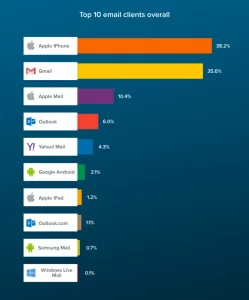After a few months since Apple’s Mail Privacy Policy (MPP) became effective, in this blog post we have tried to shed some light on a topic that worries many industry experts, we will give our point of view to the following questions: Is Apple’s Mail Privacy really something new? What is the real scope of Apple’s new privacy policy? What challenges has it brought about? If you want to know more, don’t miss this post.
Is Apple’s Mail Privacy really something new?
Apple’s Mail Privacy is really nothing new, that is, some of the main ISPs such as Gmail or Yahoo have already implemented a similar system for the privacy of users. I mean, Gmail in 2013 and Yahoo in 2018 implemented image caching, this means once the mail is opened the images of the email and including tracking pixels are downloaded from the original server and stored on proxy servers. Subsequent views of the email will then be loaded from the same proxy, this means that only the first download will be recorded and multiple interactions with the emails cannot be measured.
So, the question is, what is the difference to Apple’s Mail Privacy? If we have said that in the case of Yahoo and Gmail the images are downloaded once the email has been opened, in the case of apple it is once the email has been delivered. The main implication is that regardless of whether the user has opened the email or not they will be shown as opens when they really don’t have to be.
What is the real scope of apple’s new privacy policy?
First of all it is important to understand the difference between email providers (MBPs), these are companies that host subscribers’ mailboxes and email clients. Apple Mail Privacy (MPP) is not a specific function of apple mailboxes, i.e. iCloud (MBP). It is a general feature of the native Mail application itself that is built into apple devices (iPhones, iPads and Macbooks).
As an example, if you use a gmail email and you have it configured in the Mail app on an apple device, it may be affected by Apple’s Mail Privacy (depending on whether or not you accept the policies).
The next question at this point is, what percentage of users may be affected by the MPP?
According to an annual study by Litmus on email client market share show that Apple iPhone (iOS Mail), Apple Mail (macOS Mail) and Apple iPad (iPadOS Mail) had more than 46% of email opens combined in 2021.

What are the challenges?
In a world where open rates are becoming an increasingly imperfect metric, it will be important to rely much less on open rate and focus on other metrics to get a more detailed view of the performance of our email marketing programme.
Here are some of the solutions we have been able to detect in recent months:
Database hygiene: Spamtrap monitoring has a role to play, especially recycled traps that have been reused by MBPs because they are inactive. An increase in recycled traps indicates that interaction age management should be strengthened and analysis of trap ageing helps to measure this trend.
0 Party data: This is data that a customer intentionally and proactively shares with a brand. It can include preference centre data, purchase intentions, personal context and how the individual wants the brand to recognise them. It will be important to communicate the value of this data type and how it can benefit customers.
Engagement and more engagement: If you have been following us for a long time, one of the infallible factors to improve email marketing performance is the engagement of our communications. That is, focus on really interacting with those users who want to receive our communications and not those who are less active.
Click rate: Metrics such as click rate have become increasingly essential for the traceability of these. It also helps us to understand in a deeper way who are the users who are really interested in our content.
Focus on Deliverability: It will be increasingly important to have a control of how users of different ISPs behave in the inbox in order to optimise the results of our email marketing programme.
If you want to know more information about how to optimise the deliverability of your email marketing programme, don’t hesitate to contact us.




 Gracias por contactar a Data Innovation. Somos expertos en impulsar el crecimiento de negocios a través de la optimización de datos y CRM. ¿En qué podemos ayudarte hoy? Estamos aquí para ofrecerte las mejores soluciones. Cuéntanos más sobre tus intereses o preguntas.
Gracias por contactar a Data Innovation. Somos expertos en impulsar el crecimiento de negocios a través de la optimización de datos y CRM. ¿En qué podemos ayudarte hoy? Estamos aquí para ofrecerte las mejores soluciones. Cuéntanos más sobre tus intereses o preguntas.